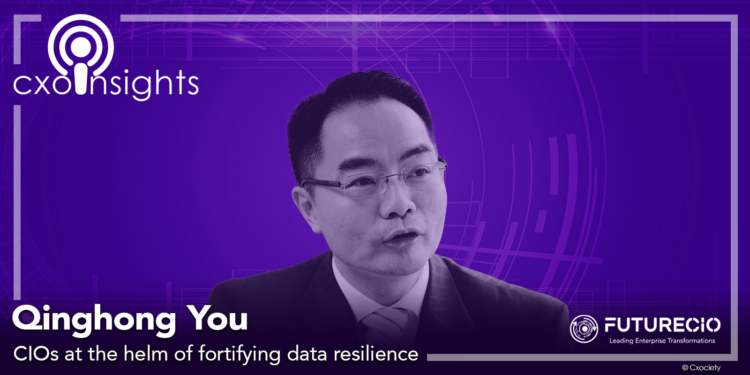infrastructure continues to decline over the next two years." It predicts that by 2025, over 50% of businesses will modernise up to half of their cloud architecture to boost efficiency and drive innovation. But that doesn't necessarily mean that traditional IT infrastructure like on-premises data centres is doing away. This implies that the IT team is on track towards a more complex IT infrastructure that includes both on-premises and cloud infrastructure, mobile devices, and connected IoT devices.
IDC's Data Age 2025 paper forecasts that in 2025, the global data sphere will grow to 163 zettabytes, 10 times what it was in 2016. As organisations strive to unlock unique user experiences and discover new world opportunities, the challenge for the CIO and IT team is managing, storing, and securing their most critical data.
On World Backup Day 2025, the importance of robust data backup strategies for Asian organisations becomes increasingly evident as businesses face a surge in cyber threats and data loss incidents.
The IT department must implement advanced backup solutions and foster a culture of data resilience within their organisations. By prioritising comprehensive backup protocols, these leaders ensure that critical data remains secure and recoverable, safeguarding against potential downtime and financial loss.
As organisations navigate the complexities of digital transformation, the proactive engagement of IT leadership in backup strategies is essential for maintaining operational continuity and protecting valuable assets in an ever-evolving threat environment.
The evolution of backup beyond storage
Backup strategies have transformed from storage solutions to critical defence mechanisms against data loss and cyber threats. With data now distributed across multiple devices and locations, backup must adapt to ensure data mobility, instant recovery, and AI-driven insights for proactive risk mitigation.
Qinghong You, Solutions Engineering Lead (Greater China, ASEAN and South Korea), NetApp, notes, "Data has become the most valuable corporate asset, transforming backup from simple storage to a critical defence mechanism." AI enables proactive threat detection, while instant recovery capabilities address the need for rapid business continuity in a fast-paced digital environment.
Role of data mobility in hybrid cloud environments
Data mobility enhances backup strategies, especially in hybrid cloud environments. Concepts like NetApp's Data Fabric enable seamless data movement across hybrid multi-cloud environments, ensuring consistent protection policies and quick, performance-optimised data recovery regardless of location.
You highlight the importance of this flexibility, stating that "Data mobility reflects the modern workplace's flexibility, where professionals work across various devices and locations." He posits that this approach supports deploying applications and mirroring business data efficiently, ensuring consistent protection policies and enabling quick recovery.
Enhancing backup with intelligent data infrastructure
Enterprises can improve backup strategies by integrating AI-driven intelligent infrastructure. This involves treating data as a product through comprehensive classification, allowing AI to learn organisational data behaviours and detect anomalies in real time.
"AI-driven intelligent infrastructure learns organisational data behaviours, detecting anomalies in real-time," explains You.
He asserts that organisations can automatically identify potential ransomware threats by integrating snapshot-based backup with AI monitoring and ensuring rapid, secure data recovery across diverse computing environments.
Transitioning to intelligent data infrastructure
Shifting from traditional backup to an intelligent, always-available data infrastructure requires rethinking the 3-2-1 methodology. The focus should be on data classification, understanding critical data sets, and developing infrastructure that supports backup and recovery across multiple environments. You suggest prioritising snapshot-based approaches, leveraging cloud capabilities, and creating flexible strategies that adapt to evolving business needs and technological landscapes.
Contribution of AI to backup solutions
Modern backup solutions integrating AI technologies enhance data resilience by learning organisational data behaviours, detecting anomalies, and automating protection mechanisms. These intelligent systems can monitor data patterns, identify potential threats in real time, and take proactive measures. By using advanced language models, backup solutions can more effectively predict and prevent potential data breaches.
Automatic response to anomalies
When an AI system detects an anomaly, such as a potential ransomware attack, modern AI backup systems can automatically respond. Solutions are now available that can detect with high accuracy threats as they come.
The integration of AI with automation technologies offers the promise of autonomous protection. Acknowledging that not everyone may be ready to relinquish control of machines, organisations can customise settings to require human intervention if needed.
Best practices for resilient backup strategies
Beyond using tamper-proof copies, organisations should classify data as a product and understand critical data sets and their value. Developing an infrastructure supporting backup and recovery across on-premises and cloud environments is essential.
You suggest leveraging AI-driven tools to automate protection, optimise storage costs, and ensure flexible data management. Prioritising multi-cloud compatibility and intelligent data classification strategies will help organisations maintain a resilient and cost-effective backup strategy.
Strategic advice for CIOs
Given the rapid evolution of technology, changing regulations, and persistent cybersecurity threats, CIOs and IT leaders must proactively adapt their data protection strategies. You advise staying ahead of emerging technologies, understanding evolving regulatory landscapes, and implementing agile, AI-driven security frameworks.

"Continuous learning, strategic vendor partnerships, and a holistic approach to digital resilience will be critical in safeguarding organisational data and infrastructure against future cyber risks." Qinghong You
Click on the PodChats player to hear your views and suggestions on how CIOs and heads of infrastructure can fortify their organisation's data resilience in detail.
- How is backup evolving beyond just storage (storage is cheap), focusing on data mobility, instant recovery, and AI-driven insights for proactive risk mitigation?
- What role does data mobility play in enhancing backup strategies, especially in hybrid cloud environments?
- How can enterprises enhance backup strategies with an intelligent data architecture to improve anomaly detection, automation, and cyber resilience against ransomware threats?
- What are the key considerations for shifting from traditional backup to an intelligent, always-available data infrastructure that minimises downtime and ensures seamless disaster recovery?
- How do modern backup solutions integrating AI technologies contribute to a resilient data infrastructure?
- Technology, regulation, and threats continue to evolve. What is the last piece of advice for CIOs and those responsible for resilience data protection in 2025?





